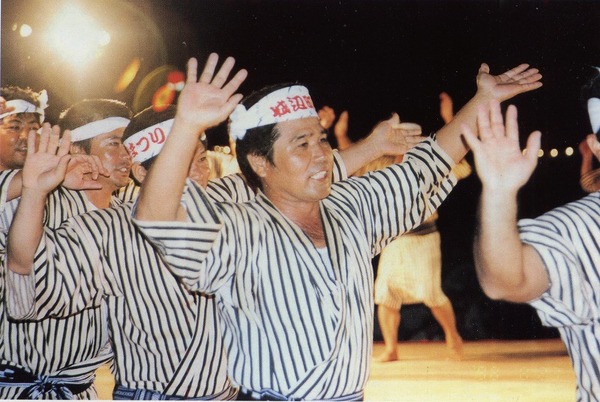トップ > 市の組織 > 教育委員会 > 生涯学習部 > 生涯学習振興課 > 【市指定:無形民俗】友利クイチャー
【市指定:無形民俗】友利クイチャー
〔ともりくいちゃー〕
昔、ブンミャー(村番所)で機織りさせられた女性等は、リーフに織り成す白波が上布の模様に見える事から、小浜の砂が粟になれとの願いをこめてクイチャーアーグに仕上げたという。昼間の労働から開放された若者達は夜の巷に集まり、面白おかしく男女の様子まで歌い踊ったりしたという。
友利のクイチャーは、最初にマキャーブドス(巻円陣)を踊る。踊手全員が円陣を作り、体は円の中心に向かって足を交互に踏みながら手拍子を取ってクイチャーアーグを歌う。歌が終わると全員右に向きを変え囃しながら4、5番程度踊る。その後、クイチャーに移るが、これも、マキャーブドス同様体は円の中心に向かって歌う。歌が終わると、今度は、向きを左に変え囃しながら威勢よく大地を踏み鳴らして踊る。
友利のクイチャーは男踊り、女踊りの別はなく、男女一緒に大地を踏み鳴らして踊る威勢の良さが特徴である。
【Designated by the City:Intangible Folk】Kuicha of Tomori
Long ago, women who engaged in weaving at a village guardhouse on orders are said to have likened white-crested waves on a reef to patterns of Jofu, or hemp cloth, and arranged Kuicha Agu folk songs, wishing the sand on at the beach would turn into millet grains. Being freed from the daytime work, young men and women gathered on a street at night and sang and danced humorously about various affairs including those between men and women.
Kuicha of Tomori begins with the Makyabudosu (spiral) dancing. All the dancers form a circle, step in place with their bodies facing the center, and sing Kuicha Agu, while clapping their hands. When a song is finished, they all turn right and sing four or five verses again while beating a rhythm. Then, they move on to Kuicha. Similar to Makyabudosu, they sing with their bodies facing the center of the circle. They turn left next, and dance while beating a rhythm and vigorously stamping the ground. There is no distinction of men and women in the dancing of Kuicha of Tomori. Energetic dancing and stamping by men and women together is its distinctive character.
【市指定:無形民俗】友利和聲舞(Kuichaa)
以前,在村番所進行紡織工作的女性們,看到如葉子般層層相疊的白色浪花,不由聯想到上布的模樣,將希望小濱的砂子能夠變成粟米的心願,編成了和聲舞民謠。從白天的勞動中,得到了放鬆的年輕人們,聚集到夜晚的巷子裡歡歌起舞,譜寫出奇妙有趣的男女模樣。
友利的和聲舞首先跳麻恰布道姿(卷圓陣),全體舞者排成圓形隊伍,身體朝向圓圈的中心,雙腳交互踩踏,並用手打拍子,合唱和聲舞民謠。唱完後,所有人向右轉身,邊打拍子邊重複4、5次相同的動作。接下來開始一起跳和聲舞,這也與卷圓陣相同,面朝圓圈中心唱歌。唱完後,這次則向左轉,邊打拍子邊用力踩踏大地歡快起舞。
友利的和聲舞並沒有因為男女不同而有所區別,男女一同腳踏大地雄壯起舞的樣子,才是其特色所在。
【미야코지마시 지정:무형 민속】도모리 구이차
옛날에 분먀(마을 관리소)에서 직물짜기를 해야 했던 여성들은 암초에 부딛히는 하얀 파도가 조후(고급 마포) 무늬로 보이는 것에 착목했다. 바닷가의 모래가 좁쌀이 되기를 기원하면서 구이차아구 노래를 만들었다고 한다. 낮의 노동에서 해방된 젊은이들은 밤에 모여 남녀의 연정을 노래하고 춤으로 표현했다고 한다.
도모리의 구이차는 처음에 마캬부도스 춤을 춘다. 춤추는 사람 모두가 원을 짜고, 몸은 원형의 중심을 향하면서 발을 서로 밟으면서 박수를 치며 구이차아구 노래를 부른다. 노래가 끝나면 모두가 오른쪽을 향하고, 노래하면서 네, 다섯번에 걸쳐 춤을 춘다. 그 다음, 구이차로 들어가지만 이것도 마캬부도스 춤과 마찬가지로 몸은 원의 중심을 향하면서 노래한다. 노래가 끝나면, 왼쪽을 보면서 노래하고 힘차게 땅을 구르며 춤춘다. 도모리의 구이차는 남성춤과 여성춤의 구별이 없고, 남녀 함께 땅을 구르며 힘차게 춤추는 것이 특징이다.
生涯学習部 生涯学習振興課
電話:0980-72-3764






